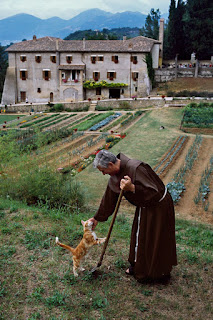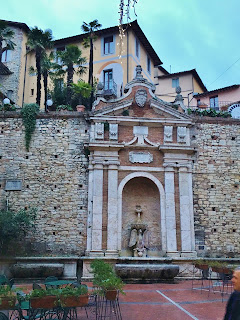Umbria is full of delightful Medieval hill towns that have changed little in hundreds of years. The often remote mountainside settings of Umbria's villages makes one believe that they have stepped back in time as they wander the streets. While I was standing on a terrace in one of these quiet towns overlooking the verdant countryside, monastery bells began to softly chime and echo through the mist. Something stirred inside my soul. It is easy to see how Umbria's mysterious beauty is the starting point of a Spiritual journey for so many.
 |
| Umbrian Countryside in Winter |
Ireland is often referred to as the land of "Saints and Scholars" for keeping an intellectual light on during the Dark Ages. Yet Umbria is a unique region of Italy that is also known as "The Land of Saints." Umbria has produced so many saints: Saint Benedict founder of the Benedictine Order, Saint Rita, Saint Valentine (yes, like Valentine's Day) St. Claire of Montefalco, the other Saint Claire of Assisi, a few Saint Fortunatus', and so many others. The MOST famous and beloved Saint of Umbria (and probably all of Italy) is Saint Francis. On our recent trip to Umbria, we discovered how this Saint is so enmeshed with the day to day life of the Umbrian people; it is impossible to talk about Umbria without mentioning Saint Francis.
Saint Francis was a real rebel and was hugely popular in his own lifetime; as a rock star for his day. Here's a quick breakdown of St. Francis's life story. He was born around 1182, and his name was actually Giovanni, not Francis, but his Dad nicknamed him Francesco meaning "little Frenchman." Francis's Mom was a Noble from Provence, France, and his father was a very wealthy cloth merchant. Francis enjoyed the easy life of a rich kid; fancy clothes, lots of parties, lots of girls, and he loved hanging out with Troubadours. That all changed when Francis was 20 years old and joined a military expedition against Perugia, where he was captured and spent a year as a prisoner. He got very ill during his imprisonment, and Francis re-evaluated his life completely. Long story short: he ended up rebelling against his wealthy father in front of the Bishop of Assisi and the whole town, stripping naked and throwing his fancy clothes in his father's face. Francis renounced his father (and his hefty inheritance) and went to go live in a nearby cave in the forest above Assisi. Francis preached to the birds and animals for a while; he especially loved the birds and is often pictured with a bird in his hand.
 |
| Camino di Francesco |
 |
| I Agree Completely! |
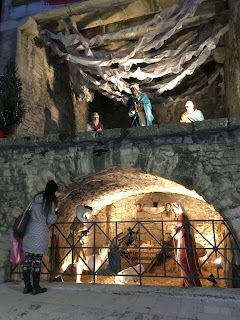 |
| Checking Out The Presepe in San Marino |
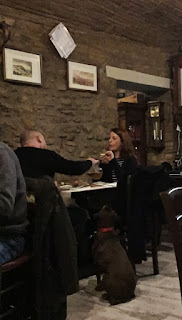 |
| The Wolf Of Gubbio? |
Stories can stretch eons of time. When travelling through Gubbio on New Year's Eve, we stopped in for lunch in this little trattoria called "Saint Francesco and The Wolf." The name was odd, so we thought: heck ya, let's go in. We were seated at a table next to a fresco of Saint Francis and a bunch of concerned monks talking to a wolf, and it looked like something big was going down between them all. Then I noticed that several tables in the restaurant had guests that brought their dogs in with them! This was SO COOL! I asked our server about the fresco, and she told us to go around the corner to the tiny little church of San Francesco della Pace, and it would explain everything to us. Ooooo, I love a good mystery. After lunch, we went to the little chapel and there, above the door, was a Latin inscription carved into the stone; it said: "Dedicated to God and Francis, the peace bestower." There was also a picture of a wolf carved into the rock on the doorway...but what does it all mean?
 |
| YOU go talk to that wolf... |
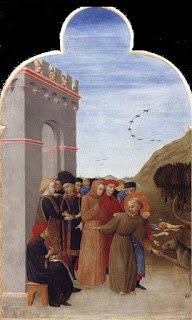
Two years later, when the wolf died (probably from excessive weight gain), the people of Gubbio were so sad they buried the wolf where his cave was supposed to have been. They then built a church dedicated to "Saint Francis and Peace" over their beloved wolf.
This is a beautiful story; a fairytale, right? Here's the crazy part: In 1873, while renovating the church, a large wolf skeleton was unearthed right outside the church wall! The giant skeleton was reported as looking like it had been there for centuries, and the remains were brought inside the church and buried in the crypt. I could not believe it! We talked for days about this story and came up with our own conspiracy theories on what happened. What do you think happened?
When Saint Francis died in 1226, he was put on the expedited list for Sainthood (by his former friend) Pope Gregory the IX and only two years after his death, Giovanni di Pietro di Bernardone became Saint Francis of Assisi. The day after Francis was pronounced a Saint, the cornerstone was laid on the beautiful Basilica dedicated to him in the Spiritual capital of Umbria: Assisi. This gorgeous white Basilica is where Saint Francis's final resting place is now; after the Church lost his bones for a few centuries (but that's a whole other story).
In Umbria, you can walk through the same forests as Saint Francis did, be inspired by listening to the same birdsong as Saint Francis had and fill your heart with the same wonder and beauty as St Francis felt 800 years ago. The connection with nature and with tradition is ingrained in the Umbrian people as a result of Saint Francis. His teachings and many words of wisdom still ring true over the centuries. May a visit to this green and mystical corner of Italy inspire you on your own spiritual path!

